The Singing Bowl Types
Some researchers have identified almost 50 types of antique Himalayan singing bowl, but there are only seven or eight basic kinds, each with its own characteristic shape and sound, and perhaps another seven less familiar types with subtle variations of form. There is general consensus among experts about the naming and classification of the major bowl types, but little agreement about some of their less common variants. Some bowl authorities have assigned their own unique names to them, and whilst these may become generally accepted over the course of time, the present situation is that another specialist may call the same bowl form something entirely different. We have chosen to classify our antique singing bowls as follows : –
Thadobati Singing Bowls
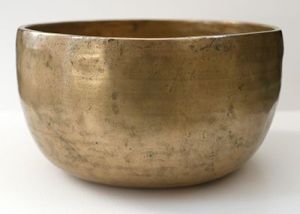

Thadobati Singing Bowls are among the oldest bowl forms, with some examples dating back to at least the 16th century. I believe they originally served a ritual or healing purpose, but many have since been employed as utilitarian pots and pans during their lifetime and show signs of considerable us; their hammered walls and decorative and ritual markings worn down and made faint. Old Thadobati bowls are fairly numerous and relatively inexpensive, so they are often the first bowl a person buys, but their quality varies considerably and good ones are increasingly hard to find.
Thadobati bowls have diameters that typically range from 4 to 9 inches (10 to 23 cm). They are characterized by having almost straight high-sided walls and a flat bottom, the diameter of which is sometimes only a little less than that of the top. Walls can be thick or thin, but older, extra-thick and heavy Thadobati bowls frequently have slightly lumpy and uneven walls due to difficulties encountered during the forging process. The lip is usually sheered and plain on small and medium weight bowls, while heavier bowls have thicker and wider lips that may be grooved.
Decoration varies according to age and function. Most feature a parallel pair of tiny punched dots or gashes encircling the outer rim to form a collar, and there are always some concentric circles radiating from the centre of the bowl. Older Thadobati bowls are more extensively decorated with a ribbon of Mala Beads or Sun symbols (dots within circles) set within a pair of parallel lines around the rim, or sometimes between two band of circles at the bowl’s centre. Very rarely one will come across a bowl that features a decorative fringe of suns arranged as downward facing triangles, like bunting, at the quarter points around the rim. The suns are often worn down so that only the deeper dots at their centre remain.
Older Thadobati Singing Bowls sometimes feature magical, sacred, or ritual marks in the form of groups of 3, 4, or more gashes at intervals around the upper wall. I believe they relate to the bowl’s initiation (they also appear on some Manipuri bowls). It’s extraordinary to think that a once pristine and perfectly forged singing bowl had to undergo such crude and seemingly random hacking before it was fit to serve! Occasionally one finds an antique Thadobati bowl with a dot-punched inscription or dedication, but never an engraved one.
Very few Thadobati singing bowls have talking or fountain abilities, but they do have wonderful singing voices with notes covering the entire chromatic scale from the 2nd to 4th octave when struck, sometimes higher when played around the rim. As with all bowl types, some notes are rarer than others. Thadobati bowls are generally hand held and easy and rewarding to play with either a suede or wooden ringer, although small bowls respond better to the latter. They don’t have particularly long sustains when struck so are more commonly played around the rim, and the rim note may change with the type of ringer used. Large bowls sing beautifully with a suede ringer. Very large, extra-thick, and heavy Thadobati bowls in a good state of preservation (free of major stains and blemishes) are highly prized by sound therapists/healers and collectors.
Jambati Singing Bowls
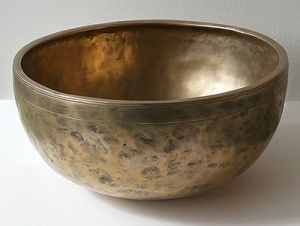
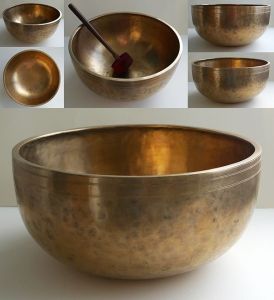
Jambati Singing Bowls are the largest and heaviest of the antique singing bowl family, and arguably the most beautiful. They date from the 15th or 16th century, although the majority in circulation today are 18th and 19th century. I believe they were made mainly for ceremonial use, with larger examples being commissioned by or for Monasteries and Temples. This would perhaps account for their generally good state of preservation compared to some other bowl types, but they are also known to have been used for the dry storage of grain during their lifetime.
Jambati bowls have diameters that range from 8 to 15 inches (20 to 38cm) and their notes cover the entire chromatic scale from the 1st to 4th octave when struck with a padded mallet or played around the rim with a suede ringer, sometimes higher with a wooden ringer. As with all bowl types, some notes are rarer than others. These glorious singing bowls are characterized by their full-bodied and gracefully curved walls, a smallish flat or rounded bottom, and typically a generous triangulated inward-facing lip that may be plain or grooved. In some bowls the lip is simply the sheered top of the wall. Decoration is minimal, often confined to a pair incised bands encircling the outer rim to form a collar, and some concentric circles radiating from the centre of the basin. These hand-beaten bowls nearly always have attractive hammer markings arising from the forging process. They are particularly evident on the outside of the bowl where they subtly reflect the light. High quality bowls tend to have smaller hammer marks, and sometimes an incised (not dot punched) inscription, usually a name or dedications, never a date. It takes at least 4 highly skilled craftsmen working together to forge a Jambati bowl, and a lot of valuable metal. Commissioning such a bowl would have been a major expense for its original owner.
Jambati singing bowls are capable of producing wonderfully low resonant and sonorous tones with a long sustain. They are very responsive and easy to play. Fundamental notes generally range from the 2nd to 4th octave when struck with a padded mallet. The rim note is usually the same if played with a suede ringer, but may be higher if a wooden one is used. Most bowls have complex multiple overtones. Some fundamental notes, such as F# and G#, are fairly abundant, while other notes are more illusive. In general the larger a bowl is the lower its octave.
Some people choose only to strike their Jambati bowl, while others prefer to play them. Both methods require a little practice to realize a bowl’s full potential. A medium weight Jambati can be held in the hand and played around the rim, but the larger bowls are too heavy and need to be placed on a mat or cushion. Jambati bowls do not have talking ability, but many are capable of producing vibrant surface patterns and spectacular fountains when played around the rim with a little water inside. This is particularly true of large low octave bowls, and second octave bowls are particularly sought-after. Jambati bowls are very popular and commonly used in a variety of healing therapies including chakra balancing and sound bathing. Practitioners frequently endeavor to make Chakra sets of 7 bowls, one for each note (or 12 including sharps and flats). This is relatively easy with mixed sizes and octaves; but very difficult within a single active, especially in a uniform size.
These handsome bowls display well and look and sound wonderful, and no collection would be complete without at least one. They are my personal favorite, and if I could only have one bowl it would be a Jambati!
Chalice Singing Bowls


Chalice Singing Bowls, also known as Pedestal, Naga, or Stem Bowls, are forged in two parts…the bowl itself, and a circular metal band, or pedestal, upon which the bowl is securely and permanently mounted. Little is known about their origin and function. Their generally good state of preservation suggests they have been well cared for, and perhaps served a musical, ceremonial or sacred purpose…possibly as offering bowls and altar-pieces. This view is supported by the high proportion of Naga Pedestal bowls carrying inscriptions or dedications dot-punched (never engraved) on the outside wall.
Chalice bowls are quite bulbous, with the midpoint having a larger circumference than the rim. Their height and diameter typically ranges from 4 to 8 inches (10 to 20 cm). Ornamentation is generally limited to four pairs of finely incised parallel lines just below the outer rim, and occasionally a small circle in the centre of the bowl. The lip is normally plain but may be grooved on thicker and heavier bowls. Inscriptions often begin and end with a delicate dot-punched drawing of an animal, a fish or peacock for example, or sometimes a lotus.
Chalice Bowls are self amplifying and played around the rim rather than struck. They produce an unexpectedly loud, bright, and piercing sound and are extremely responsive and easy to play. Their notes tend to be in the middle to high octaves. Antique Chalice Bowls are very popular with sound therapists and healers, as they can be gripped by the pedestal and positioned at any angle or distance above, around or below a client during a treatment. Feng Shui practitioners also use them for space clearing. Chalice bowls display well when not in use, and also make attractive receptacles for sacred items such a prayer beads.
Mani Singing Bowls

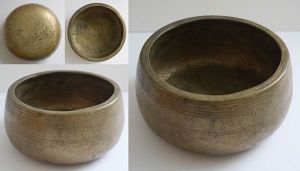
Mani Singing Bowls have a strong physical presence, a powerful voice and a character all their own. They are sometimes likened to an elephant’s foot, having a similar shape, or a begging bowl that traps tossed coins inside with its wide inward-facing lip. Their diameters range from 4 to 9 inches (10 to 23 cm) and their notes typically occupy the 4th and 5th octaves. They are distinguished by their unique sound and unusual conical form that hardly varies from one bowl to the next. Mani are very substantial and heavy flat-bottomed bowls with conical walls that taper towards the mouth. Their lips are wide and inward facing, and their bulbous bellies have a circumference that is usually greater than their base or rim. Decorative markings are limited to a grooved lip, some small concentric circles on the floor inside, a few bands of incised lines just below the outer rim and occasionally around the mid-point of the belly. Their walls are smooth inside and out. Mani bowls do not talk or fountain, and I have never seen one bearing an inscription.
Mani bowls produce a very distinctive sound. Their unusual self-amplifying shape results in a powerful and penetrating repetitive oscillation or sine wave. Most bowls are extremely responsive and easy to play with a hardwood ringer, but some can be a little temperamental and slow to get going. Some people like to collect and play them in pairs for their unique harmonic and entrainment qualities.
Mani singing bowls date from the 16th to 18th century and are very rare and increasingly difficult to source.
Ultabati Singing Bowls

Ultabati Singing Bowls are impressively large, capacious and caldron-like. They may have their origins in East Nepal, but little else is known about them. They are often found in a good state of preservation…evidence that they have been well cared for, so it is likely that they have served a ceremonial, ritual or musical use, as well dry grain storage in more recent times. Their diameters range from 8 to 15 inches (20 to 38 cm).
Ultabati singing bowls are characterized by their stunning good looks and vibrant energy. Like the Jambati, they are capable of producing wonderfully low sonorous tones with very long sustains. But they have finer walls and tend to be a little wider and squatter than the average Jambati, and this difference facilitates a lower vibrational resonance and timbre that can be physically felt some distance away from the bowl’s surface. Their fundamental notes focus on the low second and third octaves whether struck with a padded mallet or played around the rim with a leather ringer. Many are capable of producing the low humming OM sound that is favored by Buddhists and, with a little water inside, most will make vibrant surface patterns and produce spectacular fountains.
Their scooped shoulder makes them easy to distinguish from a Jambati bowl, and their hammered walls sometimes feature two contrasting surface finishes externally. A single incised line normally marks the boundary between the two contrasting areas, while the inside is often finely polished to a beautiful golden bronze. Their sheered downward sloping lips are never grooved. There are usually some decorative concentric circles radiating from its centre. Occasionally a large bowl will be found with an incised (not punched) inscription below the scooped shoulder or collar. They are now quite rare and in great demand.
Manipuri Singing Bowls
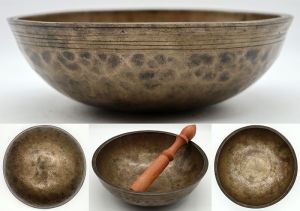

Manipuri Singing Bowls are the shallowest of the singing bowl family. Their name comes from a state in North East India, but little is known them or their function, but they are interesting and attractive bowls, easy to play, and they sing sweetly. Manipuri bowls, once plentiful in the 1980s, are now quite rare, and large or heavy examples even more so. Very small Manipuri bowls are often extensively decorated with artwork inside and out. They are responsive and easy to play but their rounded bottoms make them rotate in the palm, so are best played balanced on the fingertips. Manipuri Singing Bowls are still relatively inexpensive and therefore often the first bowl purchased.
Small Manipuri bowls are sometimes cast in sand and then hand finished, while larger ones are forged into shape and the ornamentation applied later. Diameters range from 3.5 to 9 inches (9 to 24 cm) and their notes cover the 3rd to 6th octave. They can be thick or thin, plain or highly decorated, but all are characterized by their low profile, subtly splayed rim, and rounded bottom. The lip can be plain and simple or, in thicker bowls, ornamented with sun symbols (dots inside circles). The outer rim is usually surrounded by multiple incised lines that form a decorative collar, sometimes with vertical lines below. There are normally circles at the center, although these are often faint due to wear. Some older bowls feature magical or ritual gashes in seemingly random groups of 2, 4 or more. It is extremely rare to find one with an inscription.
Many will have served a domestic or utilitarian purpose during their lifetime, and regular abrasive cleaning probably accounts for their typically smooth appearance. However, Manipuri, with their diversity of markings are among the more interesting singing bowls.
Lingam Singing Bowls
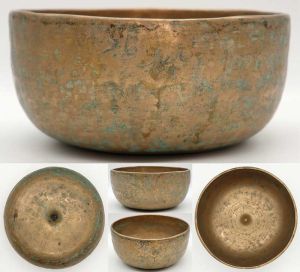
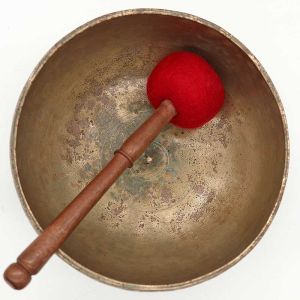
Lingams Singing Bowls are without doubt the rarest of all Himalayan bowls, and also among the oldest, with some dating back to at least the 16th century. They were made for ritual, healing, and sacred ceremonial use, and some are inscribed. Named after the male principle, embodied as the Hindu God Shiva, they are easily identified by a conical protrusion, the lingam, in the centre of the bowl. This is usually matched by a navel-like impression, or yoni, on the underside when the bowl is turned over. They are superbly crafted, responsive and easy to play, and have unique sonic qualities. Lingam bowls are different, special!
Antique Lingam Bowls come in a wide variety of shapes and sizes. They typically have diameters of between 5 and 7 inches (23 to 28 cm). Very occasionally one of 9 or even 10 inches will come to light, but anything larger is virtually unheard of! There are several extremely rare museum-quality specimens in my collection with diameters in excess of 14 inches (36 cm) and weighing well over 13 pounds (6 kilos)!
Lingam bowls are usually beautifully forged, with even walls and a smooth surface finish. Many take the Thadobati form with a fairly straight wall and sheered lip, but they can be almost any shape. Some have a large triangulated and grooved inward facing lip. Decoration is fairly consistent and minimal…perhaps a couple of concentric circles at the foot of the protruding lingam to define it, and one or two larger circles radiating from the centre of the bowl. There are nearly always a few decorative lines just below the rim on the outer wall and, very occasionally, high up on the inside too.
Their notes typically cover the 3rd to 6th octave, but the largest specimens can be 2nd octave. Antique Lingam Singing Bowls are sacred ritual and musical vessels, and for that reason they often carry inscriptions.
The sound of an old lingam bowl is very special…sweet and sonorous, sometimes pulsating, and often with a long sustain. Notes tend to occupy the middle and higher octaves, and the fundamental and rim notes are usually the same. The largest specimens can be 2nd octave. A few have extraordinary fountain abilities…the exact water volume sometimes being determined by tilting and filling the interval between engraved lines inside the bowl (this may also be the case with other bowl forms such as the Thadobati and Jambati).
Lingam bowls have massive aesthetic appeal and seldom come on the market. Prices have rocketed in recent years.
Rare Antique Lingam Singing Bowls are our speciality. We began collecting them in Nepal in the mid 1980s when there was virtually no interest in rare or unusual bowl forms regardless of their age, ceremonial purpose or exquisite sonic qualities. We were among the first in the West to appreciate their antiquity and refined beauty, discover their unique sonic qualities, and medicinal and ceremonial functions. Forty years later, almost unintentionally, I find myself with probably the world’s largest collection of these now incredibly rare and wonderful sacred singing and healing bowls. You will find more antique Lingams on this website than all the others combined.
Remuna Singing Bowls
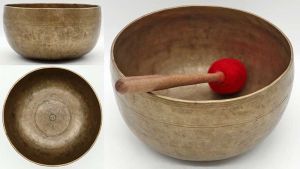

Remuna Singing Bowls have diameters that typically range from 5 to 8 inches (13 to 20 cm). They are similar to the Thadobati but have a more refined and faintly globular profile that subtly curves away from a modest flat base before gracefully curving back towards the rim. The widest part of their belly is usually just below the midpoint. They typically have thinnish smooth walls and a plain sheered or single-grooved lip. Decorative markings, if any, are limited to a few concentric circles at the bowl’s centre, and an incised line encircling the outer rim and another around the belly. Some bowls have a small raised mound on the inside floor of the basin, otherwise there is little variation in form apart from size. Remuna bowls are often found in a good state of preservation, free of stains and blemishes, and some carry a small inscription.
Remuna Singing Bowls are renowned for their responsiveness and ease of play, their notes ranging from the 3rd to 5th octave. They have particularly lovely voices that are often close to concert pitch.
Unusual and Unique Singing Bowls
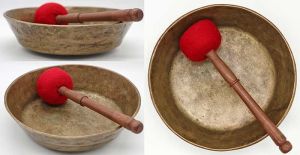
There are many factors that may lead us to describe a singing bowl as unusual or unique…such as its size, weight, decorative features or tonality…but I have chosen uncommon SHAPE as the primary unifying feature for this category. All the antique bowls in this category are therefore characterized by having an unusual shape or form. Most are, to a greater or lesser extent, variants of the main bowl types previously described, or hybrids combining elements from two or more bowl types…but some are extremely rare one-of-a-kind bowls with a truly unique form.
The shape of a bowl contributes much to the quality and character of its singing voice, and unusual bowl forms generally have interesting or even unique sonic properties that are highly prized by shaman, therapists and collectors. Unusual bowls add both interest and variety to any collection.
Shaman Medicine and Divination Bowls
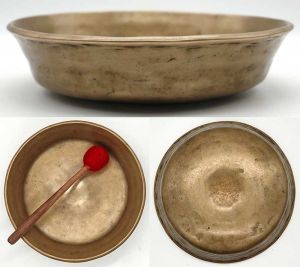
Shaman Medicine and Divination Bowls date from at least the 12th century and have diameters between 6 and 10 inches (15 to 25 cm) and are not strictly singing bowls. Their primary function is different, although they may have interesting or even beautiful voices. They are associated with rites of passage and healing rituals, and are used to help identify a physical or spiritual weakness and determine a course of action. They are quite rare, not least because Himalayan and Western bowl dealers don’t consider them to be proper (commercial) singing bowls, and choose not to stock them. Personally speaking, I find them culturally, spiritually, and aesthetically very interesting…particularly the rare Lingams and those with inscriptions and dedications. They nearly always have the look and feel of purpose and great antiquity.
They are forged and hammered into shape in the same was as singing bowls, but differ in shape by having a shallow dish-like form and a flat bottom surrounded by a low wall. In brief, they are sacred containers, used for the shamanic preparation of herbal remedies, and vessels for the display of ritual or ceremonial mandalas. Sometimes they have a raised mound or even a lingam at their centre and these features, in my opinion, are what differentiates a medicine bowl from a divination bowl. Shaman Divination Bowls requires a flat, or almost flat, bottom for interpreting vibrant rice patterns when the bowl is struck, and for examining egg yolks and entrails. The same divination bowls could also be used for the preparation of medicines and mandala displays. Interestingly, some medicine and divination bowls also have percussive potential when held like a tambourine and struck in the centre or on the rim, and I occasionally come across a bowl that appears to have been used in that way.
Antique Medicine and Divination Bowls are something of a specialist interest. They particularly appeal to shamans and collectors of rare bowls. Antique Libation and Offering Bowls are also included in this category.